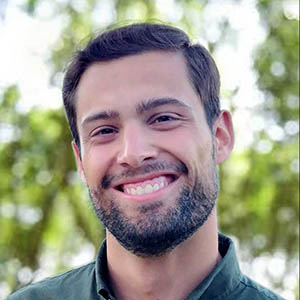Matteo Colantonio
- GARR
- https://www.garr.it
26 ottobre 2022 - SESSIONE 1 | GARR-T
Rete Ottica GARR-T: Realizzazione e Sviluppi
GARR-T Optical Network: Implementation and Developments

Rete Ottica GARR-T: Realizzazione e Sviluppi
 Matteo Colantonio ha conseguito la laurea in ingegneria elettronica all'Università La Sapienza di Roma nel 2017 e la laurea magistrale in ingegneria fotonica presso la Eindhoven University of Technology e la Scuola Superiore Sant'Anna di Pisa nel 2020. Da allora è ingegnere di rete presso il Consortium GARR dove lavora alla progettazione e alla realizzazione della rete ottica e allo sviluppo di servizi innovativi, quali spectrum sharing e QKD.
Matteo Colantonio ha conseguito la laurea in ingegneria elettronica all'Università La Sapienza di Roma nel 2017 e la laurea magistrale in ingegneria fotonica presso la Eindhoven University of Technology e la Scuola Superiore Sant'Anna di Pisa nel 2020. Da allora è ingegnere di rete presso il Consortium GARR dove lavora alla progettazione e alla realizzazione della rete ottica e allo sviluppo di servizi innovativi, quali spectrum sharing e QKD.
 Matteo Colantonio received the B.Eng. degree in electronic engineering from the La Sapienza University of Rome in 2017 and the M.Sc. degree in photonic engineering from the Eindhoven University of Technology and the Sant'Anna School of Advanced Studies of Pisa in 2020. Since then, he has been with the Consortium GARR where he works on the design and implementation of the optical backbone and on the development of innovative services, such as spectrum sharing and QKD.
Matteo Colantonio received the B.Eng. degree in electronic engineering from the La Sapienza University of Rome in 2017 and the M.Sc. degree in photonic engineering from the Eindhoven University of Technology and the Sant'Anna School of Advanced Studies of Pisa in 2020. Since then, he has been with the Consortium GARR where he works on the design and implementation of the optical backbone and on the development of innovative services, such as spectrum sharing and QKD.
ABSTRACT
 La rete ottica GARR-T si contraddistingue dalle precedenti infrastrutture di dorsale, oltre che per l'aumentata capacità dei servizi a pacchetto, per il supporto di servizi non a pacchetto. Per offrire queste funzionalità in modo scalabile è stata progettata un'interconnessione tra utenti e dorsale che eviti rigenerazioni del segnale così da ottenere continuità ottica su scala nazionale e internazionale. Questo tipo di interconnessione è necessario per soddisfare le esigenze dei nuovi modelli di calcolo e apre le porte ad interessanti applicazioni come la condivisione dello spettro e la distribuzione di chiavi quantistiche.
La rete ottica GARR-T si contraddistingue dalle precedenti infrastrutture di dorsale, oltre che per l'aumentata capacità dei servizi a pacchetto, per il supporto di servizi non a pacchetto. Per offrire queste funzionalità in modo scalabile è stata progettata un'interconnessione tra utenti e dorsale che eviti rigenerazioni del segnale così da ottenere continuità ottica su scala nazionale e internazionale. Questo tipo di interconnessione è necessario per soddisfare le esigenze dei nuovi modelli di calcolo e apre le porte ad interessanti applicazioni come la condivisione dello spettro e la distribuzione di chiavi quantistiche.
 The GARR-T optical infrastructure differs from the previous backbone networks not only because of the ten-times increased capacity of the packet services it provides but also because it supports these non-packet and non-frame services. To do so in a scalable way, we designed an interconnection between the users and the backbone that avoids electrical signal regeneration to guarantee end-to-end optical paths on a national and international scale. Such interconnection is needed to meet the future network requirements for large-scale science and enables new applications, such as spectrum sharing and QKD.
The GARR-T optical infrastructure differs from the previous backbone networks not only because of the ten-times increased capacity of the packet services it provides but also because it supports these non-packet and non-frame services. To do so in a scalable way, we designed an interconnection between the users and the backbone that avoids electrical signal regeneration to guarantee end-to-end optical paths on a national and international scale. Such interconnection is needed to meet the future network requirements for large-scale science and enables new applications, such as spectrum sharing and QKD.




